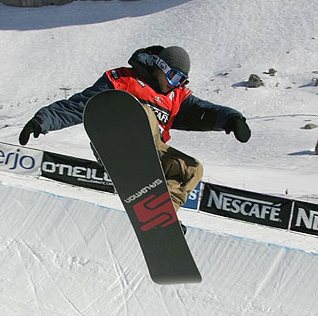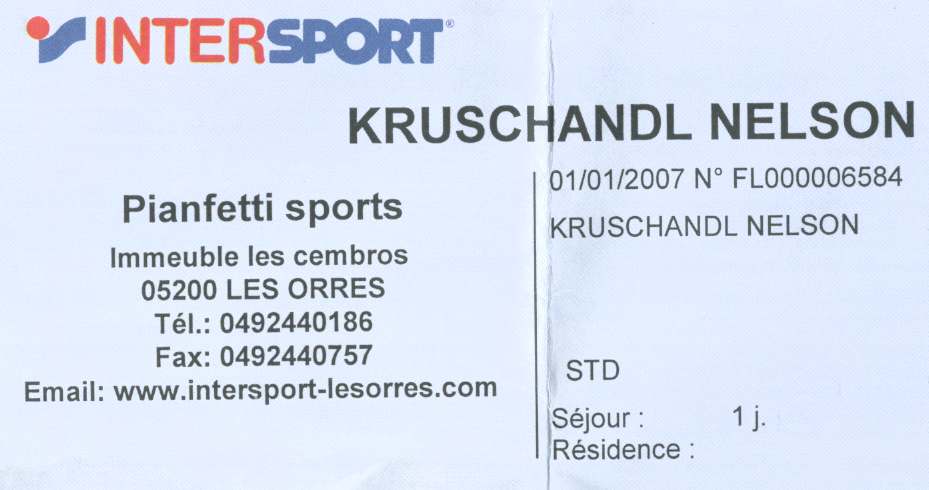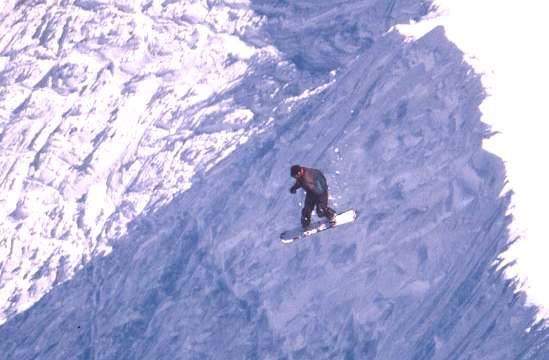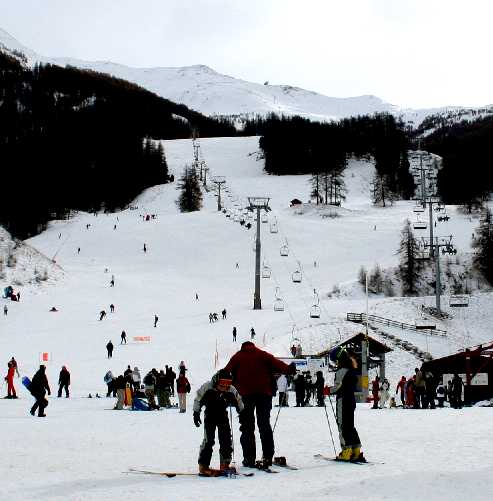|
SNOWBOARDING
|
|||||
|
HOME | BIOLOGY | FILMS | GEOGRAPHY | HISTORY | INDEX | INVESTORS | MUSIC | SOLAR BOATS | SPORT |
|||||
|
Snowboarding is a board sport that involves descending a snow-covered slope on a board that is attached to one's feet by straps. It is similar to skiing, but inspired by surfing and skateboarding. The sport was developed in the United States in the 1960s and 1970s and became a Winter Olympic Sport in 1998.
I first made my way onto the slopes at Les Orres, France, in January of 2007, having been invited to a New Year Eve party in the French Alps, by some crazy friends. The event was organized by the YesBoss team, a crew of DJs dedicated to music and having a good time on the slopes.
We set out from Newhaven in Sussex, crossing the Channel by ferry early in the morning, then drove across France via Lyon and Grenoble, to the town of Gap, which is close to several ski and snowboard venues in the French Alps.
Feeling somewhat awkward, as a result of a recently fractured rib and an impromptu overnight bout of food poisoning, I slipped into some hired boots and strapped them to a board, which at first felt restrictive, but all was soon to be revealed. Having listened to some experienced boarders and after watching a number of people on the slopes, I climbed a face of the mountain to a reasonable height, stood up and went downhill board sideways at first. You have to tilt the board backwards to slow down and try not to tilt forward, or trip and flip over. Eventually, it is possible to spin the board to go directly downhill. This is where the fun begins, because you've not yet learned to stop, and the only way is to fall backwards. This I did, several times, jarring the tender rib. However, so great was the enjoyment, that up I got and climbed the slope again.
It was not snowing, in fact it was raining. I'm told these conditions are not good, but who cares. My second descent was much better, faster and more in tune. Yet I could not master turning from downhill straight to a sideways halt, hence had to fall backwards, again jarring the rib, several times. After a few more falls I was in agony and decided to have a Suchard chocolate drink then try again. Half an hour later my third run was okay until I tried a switch, caught the leading edge and landed rather badly. I decided it was folly to continue torturing the rib on this occasion and wait until next time. NK
Snowboard half pipe turn
Equipment History
The history of the snowboard starts with pioneers like Sherman Poppen (inventor of the Snurfer), Dimitrije Milovich (Winterstick Snowboards), Bob Webber (Yellow Banana), Jake Burton Carpenter, Brandon Bridwell, Tom Sims (Sims Snowboards), Mike Olson (Gnu Snowboards), Donavin Carlberg, Chuck Barfoot (Barfoot Snowboards), Chris Sanders (Avalanche Snowboards), Steve Derrah (Flite Snowboards) developing prototypes mainly inspired by surfboards in the 1970s. This process included different stages and individual ideas and resulted in several patents for snowboard-like constructions. One of the most notable however is Bob's patent from 1972, which he sold in 1990 to Jake Burton Carpenter, founder and owner of Burton Snowboards, one of today's largest manufacturers of snowboard-specific products.
Dimitrije Milovich an east coast surfer had the idea of sliding on cafeteria trays upstate New York. From this he started developing his snowboards designs and in 1972 he started a company called the Winterstick. By 1975 The Winterstick was getting mentioned in Newsweek magazine. The winterstick was based on the design and feel of a surfboard but worked the same way as skis. Companies like Winterstick and Flite Snowboards began pressing ski-like closed molded boards from a small garage in Newport, RI. This was at least 4 years before other snowboard companies followed suite. Before that time all snowboards had been built like large 7-ply maple skateboards. By switching to closed-molded boards Flite introduced the "modern" snowboard, providing strength, lightness, and durability.
During the early years of the sport, snowboards and snowboarders were not widely respected by the ski industry and culture. Snowboarding was seen as a fad. Snowboarders were referred to as knuckle-draggers. In reaction, Transworld Snowboarding created a popular t-shirt called "Answers," which included the answers to many questions posed by skiers, including: "Yes I can stop." Many resorts did not initially allow snowboards and those which did insisted on the use of leashes and were known to insist that riders prove their ability before being allowed on the hill.
The growing popularity of the sport is reflected by the history of snowboarding as an official sport: In 1985 the first World Cup is held in Zürs, Austria. Due to the need for universal contest regulations, the ISA (International Snowboard Association) was founded in 1994. Later, the ISF (International Snowboard Federation) originated primarily due to dissatisfaction with the new ISA rules. Despite this rivalry, it was their establishment which finally convinces the IOC to declare snowboarding a new Olympic discipline in 1995. Today, high-profile events like the Olympics, Winter X-Games, the US Open, and other events are broadcast to a worldwide audience.
Snowboard equipment hire Les Orres, France 2007
Instruction
Snowboard instruction from certified snowboard instructors is available at most ski resorts. Professional instruction is a good way to learn proper technique, safety policies, mountain etiquette and resort rules. Beginning snowboarders, whether young or old, should consider taking a series of lessons. Lessons are not only the fastest way to learn, but they also build confidence in sharing the mountain with other members of the snowboarding/ski community.
Typically, beginner snowboard lessons focus on very basic, common snowboarding skills. The first lesson often begins with basic safety policies, stretching, and learning to fall, then progresses to snowboarding with one foot on the board (particularly skating and S-turns). Learning to snowboard with one foot strapped into the board is a particularly useful skill because it is necessary to disembark from the lift successfully. Then students learn how to turn and stop with both feet in. Other important beginner skills to learn are the falling leaf technique, side-slipping, and lift procedures. More advanced techniques that are taught in later lessons are linking turns, edge control, weight distribution, edge pressure, and eventually carving. As students progress in ability they can seek out specialized instruction in areas such as riding steeper slopes and through a wider variety of snow conditions, terrain park skills (jumps, rails, and pipes), mogul technique, off-piste riding, powder riding, and racing.
Freestyle snowboarding
Freestyle snowboarding owes much of its form and content to skateboarding, and many of the maneuvers common to snowboarding exist in skateboarding as well. Though the last decade has seen the trend reverse, with tricks unique to snowboarding cropping up in skating (witness the adaptation of the rodeo in skateboarding by Shaun White), the great majority of terminology is still borrowed from skateboarding.
Ollie: The fundamental freestyle maneuver is the ollie; an ollie is essential for most tricks. The ollie is not a hop, as is commonly thought, but a technique which amplifies the power of the legs by exploiting the natural flex of the snowboard. A snowboard is essentially a flat spring. The core has elastic properties and can store and release energy which can be used in an ollie. An ollie is executed by shifting body weight to apply pressure to the tail of the snowboard while simultaneously lifting the nose upward and then releasing the tension from the tail in a jump. Executing an ollie properly requires timing and coordination in a complex series of motions. The ollie was developed and named after Allan "Ollie" Gelfland, a skateboarder who first adapted the ollie to vert and bowl skateboarding in the late 70's and early 80's.
Frontside vs Backside: This distinction is essential to understanding freestyle snowboarding and is borrowed from surfing, which uses it to distinguish different types of waves. Because a snowboarder stands sideways on the board, turns and movements are asymmetrical; a turn on the heels looks different and requires different movements than a turn on the toes.
The frontside/backside dichotomy is useful for understanding terrain and tricks, though it can be confusing. Backside and frontside tricks are opposite between jibbing(rails, boxes,etc.) and jumping. In jibbing, a regular-stance(left foot forward) rider might perform a backside boardslide by jumping on to a rail from the right side, resulting in the rider sliding down the rail with his or her front side facing down the hill. This confuses most people as the rider's front side is facing down the hill, which causes people to believe the trick to be a frontside trick. This is incorrect. In jibbing, the distinction of whether a trick is a frontside trick or a backside trick is from which side of an object the rider enters on, and the rider's stance. In the image labeled 'A backside boardslide,' the rider came from the left side of the jump, riding goofy footed(right foot forward) and spun to his right onto the rail. Because the rider is goofy footed and he entered the rail from the left, this puts the rail behind him, which makes the trick a backside boardslide. All rotations are either backside or frontside, as well; if one jumps and turns looking downhill, the spin is frontside, but jumping and turning one's back to the fall line is a backside spin. When applied to terrain however, the frontside/backside distinction is different; a halfpipe for instance, has frontside and backside walls.
If one were to straight run down the middle of the halfpipe, the rationale would be apparent; the rider faces the frontside wall, and approaches on the toes, while backside wall is behind them and is approached on the heels. This applies to rails and boxes as well; the method of approach determines the name of the trick, not the direction of rotation. A boardslide, executed facing up hill, is actually a frontside boardslide, because the obstacle is approached from the frontside while if a rider is facing down the hill while on the box or rail it is backside.
Switch: This term is adopted from skateboarding and refers to riding a snowboard with the opposite stance (i.e. goofy instead of regular). Because of the twin-directional nature of most snowboards used today, riding switch is nearly the same as riding fakie. (i.e. on a twin tip board a rider will appear goofy when riding one direction and regular when riding the opposite direction). Therefore switch and fakie are commonly used interchangeably with switch being the most often used term. However the term switch is considered a misnomer since it is used as a term for riding backwards, it does does not usually refer to an opposite-stance setup. Riding switch can be considered roughly equivalent to signing one's name with the opposite hand. It requires learning each movement and maneuver over again using the opposite muscles and the opposite side of the brain.
Fakie: This term (also originating in skateboarding) refers to riding a snowboard in the opposite direction. The term fakie is only commonly used in half pipe maneuvers (when a rider will air out of the pipe vertically and gravity will bring the rider back into the pipe in the opposite direction i.e. 'air to fakie'), or occasionally in rail or box maneuvers when landing in the opposite direction.
Grabs: Grabbing the edge of the board while in mid-air. The four basic grabs are the frontside (front hand, toe edge or back hand, toe edge), backside (back hand, heel edge or front hand, heel edge), nose and tail grab. Each grab has virtually endless permutations depending on exactly where one places one's hand on the edge and what one does with one's legs (known as "tweaking", "boning" or "poking") while in the air. Some basic tricks adapted from halfpipe skateboarding are mute, melon, frontside, and stalefish. Once you move from the basic tricks that - despite tweaking in different directions - keep the board pretty much flat and going straight ahead, you move onto tricks like the method (bend knees and rotate board from backside so that the base is facing the direction of travel and grab backside with leading hand). Depending on the grab and how it is tweaked the basic method is turned into grasser, Japan air, or taipan. Some of the most stylish freestyle riders out there have their own signature way of doing this stock (basic) trick. Many other tricks are combinations of certain grabs, tweaks and maybe rotations.
Rotation: Rotation occurs when the board and body turn in relation to the fall line. The smallest possible rotation is a shifty ***which isn't technically a rotation at all***, and while theoretically limitless, a 1260 (three and a half rotations) is the largest spin currently practicable at the highest level of snowboarding. Rotations must be in multiples of 180 degrees, or in multiples of 90 degrees if onto a rail or box; less or more most often involves falling. 360s, 720s and 1080s involve taking off and landing with the same foot forward, while 180s, 540s, 900s and 1260s involve landing with the opposite foot forward. This is opposite in halfpipe spins where gravity changes your relative direction and therefore a half rotation is landed with the same foot forward as on take off and full rotations are landed with the opposite foot forward.
Manual (or "press"): A maneuver adapted from skateboarding; while traveling parallel to the fall line of the slope the rider leans over the front "nose" or rear "tail" of the snowboard until it flexes and begins to lift the other end into the air. Which end of the board the rider's weight has been placed on will determine the name of the trick (i.e., nose in the air is a "tail press" while tail in the air is a "nose press"). This maneuver may also be performed on rails or boxes.
Butter: Originally coined from the phrase "buttering the muffin", a maneuver performed on the surface of the snow or obstacle in which the rider slides perpendicularly to the fall line of the slope while in a nose or tail manual position.
Snowboarder going for it
Safety and Precautions
Although many snowboarders do not wear any protective gear, helmets and some other devices are gaining in popularity. Wearing protective gear is highly recommended due to the dangerous nature of alpine sports (especially freestyle snowboarding). The body parts most affected by injuries are the wrists, the tailbone, and the head. Useful safety gear includes wrist guards, padded or protected snowboard pants and a helmet. Goggles are also used by most people, and are very crucial at high altitudes on bright days to prevent snow blindness. Goggles also protect riders from temporary vision loss due to snow getting in eyes that can result in impact into terrain or obstacles. Padding can be useful on other body parts like hips, knees, spine, shoulders, and on the genitalia based on gender. Padding can be specialized for snowboarding, or it can cross sports. For example, knee pads used for volleyball can be useful for snowboarding. They can also be useful if a snowboarder may wish to rest on the knees, such as after coming to a stop. Helmets are also increasingly viewed as standard safety equipement for snowboarding. General safety tips for winter sports, alpine conditions and skiing should also be respected.
Mountain maintenance is a very important aspect of safety. In places where the mountains are steep and there is high snowfall avalanches are very common. In order to keep these parts of the mountain safe, ski patrol may either close or "rope off" dangerous areas, or fire explosives at the dangerous areas to trigger avalanches before anyone is allowed to ride the mountain. Riding closed trails or "ducking ropes" is extremely dangerous due to avalanches or unseen, dangerous terrain, which includes trees and unmarked objects. This practice is considered illegal by ski patrol and can result in severe consequences. When riding in areas without ski patrol an avalanche beacon, avalanche probe, snow shovel, advanced skills, experience, and a riding partner or "buddy" are required for safety. Without using the buddy system avalanche safety gear is useless.
Many environmental hazards are present in alpine locations. Dehydration, hypothermia, altitude sickness, frostbite, windburn, and sunburn can all be avoided by following standard safety precautions, taking preventative actions, and being aware of environmental conditions.
Muscle strain and injury can often be prevented by performing an aerobic warm-up or stretching session. This allows greater flexibility while riding. Areas that can be easily protected from injury by stretching include quadriceps, hamstrings, lower back, calves, and groin.
Film
Snowboarding films have become a main part of progression in the sport. Each season, many films are released, usually in autumn. These are made by many snowboard specific video production companies as well as manufacturing companies that use these films as a form of advertisement. Snowboarding videos usually contain video footage of professional riders sponsored by companies. An example of commercial use of snowboarding films would be The White Album, a film by snowboarding legend and filmmaker Dave Seone about Shaun White, that includes cameos by Tony Hawk and was sponsored by PlayStation, Mountain Dew and Burton Snowboards. Snowboarding films are also used as documentation of snowboarding and showcasing of current trends and styles of the sport.
Snowboarding has also been the focus of numerous Hollywood feature films, quite notably the 2001 movie Out Cold, which included appearances by several renowned professional snowboarders as stunt performers, actual characters, or both. Out Cold is one of few major motion pictures to show snowboarding rather realistically and to exhibit a real understanding of the sport, as well as the culture that surrounds it.
In countries where snow is either rare or an impossibility, dry slopes and indoor snow slopes are present. One such country is the UK, and this artificial snow phenomenon is well documented in the movie "Standing Sideways" by Damien Doyle.
Many snowboarding companies, such as Burton, Volcom, and Grenade, have also made their own films.
An early Hollywood nod to snowboarding was in James Bond film A View to a Kill — the beginning sequence features Roger Moore as Bond eluding attackers with an improvised snowboard.
Ski resort snow slopes and lifts @ Les Orres, France © NJK 2006
LINKS and REFERENCE
A - Z SPORTS INDEX
A taste for adventure capitalists
Solar Cola - a healthier alternative
|
|||||
|
This
website
is Copyright © 1999 & 2007 NJK. The bird |
|||||
|
AUTOMOTIVE | BLUEBIRD | ELECTRIC CARS | ELECTRIC CYCLES | SOLAR CARS |



